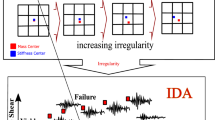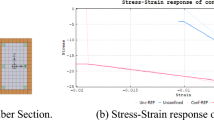Abstract
The seismic inelastic behavior of regular planar composite steel/concrete MRFs consisting of I steel beams and concrete filled steel tube (CFT) columns is investigated. For this purpose, a family of 96 regular plane CFT-MRFs are subject to an ensemble of 100 ordinary (far-field type) ground motions scaled to different intensities in order to accommodate different performance levels and their response to these motions is recorded to form a response databank. On the basis of this databank nonlinear regression analysis is employed in order to derive simple formulae which offer a direct estimation of seismic displacements, drift and ductility demands, and the strength reduction (or behavior) factor q, which describes the seismic strength requirements in order to restrict maximum roof ductility demand to a predefined value. The influence of specific parameters on the maximum structural response, such as the number of stories, the beam-to-column stiffness ratio, the column-to-beam strength ratio, the level of inelastic deformation induced by the seismic excitation and the material strengths, is studied in detail. Furthermore, emphasis is given to the ability of the proposed formulae to be employed in the framework of seismic design methods which utilize response spectrum analysis. This essential aspect makes possible both the simple and direct seismic assessment of existing structures and the straightforward deformation-controlled seismic design of new ones because the q factor is a function of deformation.

















Similar content being viewed by others
References
Ancheta TD, Darragh RB, Stewart JP, Seyhan E, Silva WJ, Chiou BS-J, Wooddell KE, Graves RW, Kottke AR, Boore DM, Kishida T, Donahue JL (2014) NGA-West2 database. Earthq Spectra 30(3):989–1005
Baker JW (2011) The conditional mean spectrum: a tool for ground motion selection. J Struct Eng ASCE 137(2011):322–331
Boore DM (2003) Simulation of ground motion using the stochastic method. Pure appl Geophys 160(3–4):635–676
Broderick BM, Elnashai AS (1996) Seismic response of composite frames—I. Response criteria and input motions. Eng Struct 18(9):696–706
Carr AJ (2006) RUAUMOKO-2D inelastic time-history analysis of two-dimensional framed structures. Department of Civil Engineering, University of Canterbury, New Zealand
CEN (1994) Eurocode 8: structures in seismic regions. European Committee for Standardization, Brussels
CEN (2004a) Eurocode 8: design of structures for earthquake resistance—Part 1: general rules, seismic actions and rules for buildings. European Committee for Standardization, Brussels
CEN (2004b) Eurocode 4: design of composite steel and concrete structures—Part 1.1: general rules and rules for buildings. European Committee for Standardization, Brussels
CEN (2005) Eurocode 3: design of steel structures—Part 1.1: general rules and rules for buildings. European Committee for Standardization, Brussels
Chopra AK (2007) Dynamics of structures. Pearson Prentice Hall, Berkeley
Dimopoulos AI, Bazeos N, Beskos DE (2012) Seismic yield displacements of plane moment resisting and x-braced steel frames. Soil Dyn Earthq Eng 41:128–140
Elnashai AS, Broderick BM (1996) Seismic response of composite frames—II. Calculation of behaviour factors. Eng Struct 18(9):707–723
FEMA (1997) NEHRP guidelines for the seismic rehabilitation of buildings, report no. FEMA-273. Federal Emergency Management Agency, Washington
FEMA (2003) NEHRP recommended provisions for seismic regulations for new buildings and other structures—Part 2: commentary, report no. FEMA-450. Federal Emergency Management Agency, Washington
Ghobarah A, Abou-Elfath H, Biddah A (1999) Response-based damage assessment of structures. Earthq Eng Struct Dyn 28:79–104
Grecea D, Dubina D (2003) Partial q-factor values for performance based design of MR frames, behavior of steel structures in seismic area. In: Mazzolani FM (ed) Proceedings of STESSA conference, Naples, Italy, 9–12 June, Taylor & Francis, 23–29
Gupta A, Krawinkler H (2000) Estimation of seismic drift demands for frame structures. Earthq Eng Struct Dyn 29(9):1287–1305
Hajjar JF (2002) Composite steel and concrete structural systems for seismic engineering. J Constr Steel Res 58:703–728
Hatzigeorgiou GD (2010) Ductility demand spectra for multiple near-and far-fault earthquakes. Soil Dyn Earthq Eng 30(4):170–183
Herrera RA, Ricles JM, Sause R (2008) Seismic performance evaluation of a large-scale composite MRF using pseudodynamic testing. J Struct Eng ASCE 134(2):279–288
Kappos AJ (1999) Evaluation of behaviour factors on the basis of ductility and overstrength studies. Eng Struct 21(9):823–835
Karavasilis TL, Bazeos N, Beskos DE (2006) Maximum displacement profiles for the performance based seismic design of plane steel moment resisting frames. Eng Struct 28:9–22
Karavasilis TL, Bazeos N, Beskos DE (2007) Behaviour factor for performance-based seismic design of plane steel moment resisting frames. J Earthq Eng 11(4):531–559
Karavasilis TL, Bazeos N, Beskos DE (2008) Drift and ductility estimates in regular steel MRF subjected to ordinary ground motions: a design-oriented approach. Earthq Spectra 24(2):431–451
Kawaguchi J, Morino S, Sugimoto T (1996) Elasto-plastic behavior of concrete-filled steel tubular frames, composite construction in steel and concrete: In: Proceedings of the engineering foundation conference, Irsee, Germany
Khashaee P (2005) Damage-based seismic design of structures. Earthq Spectra 21(2):371–387
Lepage A (1997) A method for drift-control in earthquake-resistant design of reinforced concrete building structures. Ph.D. Dissertation, University of Illinois
Lignos DG, Krawinkler HK (2011) Deterioration modeling of steel components in support of collapse prediction of steel moment frames under earthquake loading. ASCE J Struct Eng 137(11):1291–1302
Luco N, Bazzurro P (2007) Does amplitude scaling of ground motion records result in biased nonlinear structural drift responses? Earthq Eng Struct Dyn 36(13):1813–1835
MATLAB (2009) The language of technical computing—V7.8. Natick MA: The MathworksInc
Mazzolani FM, Piluso V (1996) Theory and design of seismic resistant steel frames. Spon Press, London
Medina RA, Krawinkler H (2005) Evaluation of drift demands for the seismic performance assessment of frames. ASCE J Struct Eng 131(7):1003–1013
Mwafy AM, Elnashai AS (2002) Calibration of force reduction factors of rc buildings. J Earthq Eng 6(2):239–273
Newmark NM, Hall WJ (1973) Procedures and criteria for earthquake resistant design. Building sci. series no. 46. National Bureau of Standards U.S. Dept. of Commerce, Washington
Park R (1991) Ductility of structural concrete. In IABSE Colloquium—Stuttgart, International Association for Bridge and Structural Engineering, Vol. 62
PEER/ATC (2010) Modeling and acceptance criteria for seismic analysis and design of tall buildings. Report no 72-1, Applied Technology Council. Redwood City, California
Rathje EM, Abrahamson NA, Bray JD (1998) Simplified frequency content estimates of earthquake ground motions. J Geotech Geoenviron Eng 124(2):150–158
Ricles JM, Peng SW, Lu LW (2004) Seismic behavior of composite concrete filled steel tube column-wide flange beam moment connections. J Struct Eng ASCE 130(2):223–232
SAP2000 (2013) Static and dynamic finite element analysis of structures—V16. Computers and Structures Inc., Berkeley
Schneider SP, Alostaz YM (1998) Experimental behavior of connections to concrete-filled steel tubes. J Constr Steel Res 45(3):321–352
SEAOC (1999) Recommended lateral force requirements and commentary, 7th edn. Seismology Committee, Structural Engineers Association of California, Sacramento
Shimazaki K, Sozen MA (1984) Seismic drift of reinforced concrete structures. Technical research report prepared for Hazama-Gumi Ltd., Tokyo, pp 145–166
Skalomenos KA (2014) Seismic performance of plane moment resisting frames with concrete filled steel tube columns and steel I beams. Ph.D. Dissertation, Department of Civil Engineering, University of Patras, Greece, http://hdl.handle.net/10889/8442
Skalomenos KA, Hatzigeorgiou GD, Beskos DE (2015) Modelling level selection for seismic analysis of CFT/MRFs by using fragility curves. Earthq Eng Struct Dyn 44(2):199–220
Skalomenos KA, Hatzigeorgiou GD, Beskos DE (2014) Parameter identification of three hysteretic models for the simulation of the response of CFT columns to cyclic loading. Eng Struct 61:44–60
Sorace S (1998) Seismic damage assessment of steel frames. ASCE J Struct Eng 124(5):531–540
Triantafillou TC (2013) Steel-concrete composite structures. Department of Civil Engineering, University of Patras Press, Patras
Vamvatsikos D, Cornell CA (2002) Incremental dynamic analysis. Earthq Eng Struct Dyn 31(3):491–514
Zhao XL, Han LH, Lu H (2010) Concrete-filled tubular members and connections. Spon Press, New York
Acknowledgments
The authors are grateful to the two anonymous reviewers for their suggestions and remarks, which have considerably improved the paper.
Author information
Authors and Affiliations
Corresponding author
Rights and permissions
About this article
Cite this article
Skalomenos, K.A., Hatzigeorgiou, G.D. & Beskos, D.E. Seismic behavior of composite steel/concrete MRFs: deformation assessment and behavior factors. Bull Earthquake Eng 13, 3871–3896 (2015). https://doi.org/10.1007/s10518-015-9794-2
Received:
Accepted:
Published:
Issue Date:
DOI: https://doi.org/10.1007/s10518-015-9794-2




